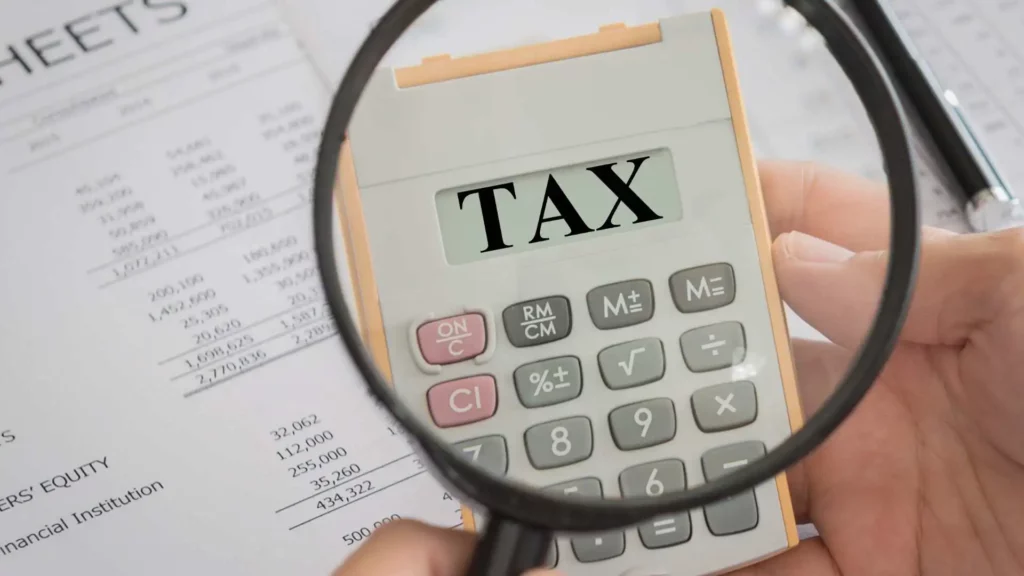According to the IRS, there are seven federal income tax brackets for 2022 (for which taxes are due in 2023): 10%, 12%, 22%, 24%, 32%, 35%, and 37%. Depending on your taxable income and filing status, you will fall into a different bracket.
How Do Tax Brackets Work?
Progressive taxation in the United States means income tax rates rise for people with higher taxable incomes.
There is no guarantee that you will pay the same federal income tax rate on every penny of your income if you are in a tax bracket. Federal income tax rates on higher incomes are higher, and those on lower incomes are lower under the progressive system.
You are taxed according to the rate applicable to each chunk of your taxable income, which is also known as a tax bracket. No matter what bracket you’re in, you won’t pay that rate on your entire income.
An effective tax rate measures how much of your taxable income you pay in taxes. A taxpayer’s effective tax rate can be calculated by multiplying the total tax owed (line 16) by the total taxable income.
Federal Income Tax Brackets for 2022
Here are the various Federal Income Tax Brackets for 2022 for taxes that are due in April 2023.
If You’re Single Filers
| Tax rate | Taxable income bracket | Tax owed |
| 10% | $0 to $10,275 | 10% of taxable income |
| 12% | $10,276 to $41,775 | $1,027.5 plus 12% of the amount over $10,275 |
| 22% | $41,776 to $89,075 | $4,807.5 plus 22% of the amount over $41,775 |
| 24% | $89,076 to $170,050 | $15,213.5 plus 24% of the amount over $89,075 |
| 32% | $170,051 to $215,950 | $34,647.5 plus 32% of the amount over $170,050 |
| 35% | $215,951 to $539,900 | $49,335.5 plus 35% of the amount over $215,950 |
| 37% | $539,901 or more | $162,718 plus 37% of the amount over $539,900 |
If You’re Married, Filing Jointly
| Tax rate | Taxable income bracket | Taxes owed |
| 10% | $0 to $20,550 | 10% of taxable income |
| 12% | $20,551 to $83,550 | $2,055 plus 12% of the amount over $20,550 |
| 22% | $83,551 to $178,150 | $9,615 plus 22% of the amount over $83,550 |
| 24% | $178,151 to $340,100 | $30,427 plus 24% of the amount over $178,150 |
| 32% | $340,101 to $431,900 | $69,295 plus 32% of the amount over $340,100 |
| 35% | $431,901 to $647,850 | $98,671 plus 35% of the amount over $431,900 |
| 37% | $647,851 or more | $174,253.5 plus 37% of the amount over $647,850 |
If You’re Married, Filing Separately
| Tax rate | Taxable income bracket | Taxes owed |
| 10% | $0 to $10,275 | 10% of taxable income |
| 12% | $10,276 to $41,775 | $1,027.5 plus 12% of the amount over $10,275 |
| 22% | $41,776 to $89,075 | $4,807.5 plus 22% of the amount over $41,775 |
| 24% | $89,076 to $170,050 | $15,213.5 plus 24% of the amount over $89,075 |
| 32% | $170,051 to $215,950 | $34,647.5 plus 32% of the amount over $170,050 |
| 35% | $215,951 to $323,925 | $49,335.5 plus 35% of the amount over $215,950 |
| 37% | $323,926 or more | $87,126.75 plus 37% of the amount over $323,925 |
If You’re Head of Your Household
| Tax rate | Taxable income bracket | Tax owed |
| 10% | $0 to $14,650 | 10% of taxable income |
| 12% | $14,651 to $55,900 | $1,465 plus 12% of the amount over $14,650 |
| 22% | $55,901 to $89,050 | $6,415 plus 22% of the amount over $55,900 |
| 24% | $89,051 to $170,050 | $13,708 plus 24% of the amount over $89,050 |
| 32% | $170,051 to $215,950 | $33,148 plus 32% of the amount over $170,050 |
| 35% | $215,951 to $539,900 | $47,836 plus 35% of the amount over $215,950 |
| 37% | $539,901 or more | $161,218.5 plus 37% of the amount over $539,900 |
Federal Income Tax Brackets for 2023
Here are the Federal Income Tax Brackets for 2023 for which taxes are due by April 2024. Make sure you select the appropriate filing status.
If You’re Single Filers
| Tax rate | Taxable income bracket | Tax owed |
| 10% | $0 to $11,000 | 10% of taxable income |
| 12% | $11,001 to $44,725 | $1,100 plus 12% of the amount over $11,000 |
| 22% | $44,726 to $95,375 | $5,147 plus 22% of the amount over $44,725 |
| 24% | $95,376 to $182,100 | $16,290 plus 24% of the amount over $95,375 |
| 32% | $182,101 to $231,250 | $37,104 plus 32% of the amount over $182,100 |
| 35% | $231,251 to $578,125 | $52,832 plus 35% of the amount over $231,250 |
| 37% | $578,126 or more | $174,238.25 plus 37% of the amount over $578,125 |
If You’re Married, Filing Jointly
| Tax rate | Taxable income bracket | Taxes owed |
| 10% | $0 to $22,000 | 10% of taxable income |
| 12% | $22,001 to $89,450 | $2,200 plus 12% of the amount over $22,000 |
| 22% | $89,451 to $190,750 | $10,294 plus 22% of the amount over $89,450 |
| 24% | $190,751 to $364,200 | $32,580 plus 24% of the amount over $190,750 |
| 32% | $364,201 to $462,500 | $74,208 plus 32% of the amount over $364,200 |
| 35% | $462,501 to $693,750 | $105,664 plus 35% of the amount over $462,500 |
| 37% | $693,751 or more | $186,601.5 + 37% of the amount over $693,750 |
If You’re Married, Filing Separately
| Tax rate | Taxable income bracket | Taxes owed |
| 10% | $0 to $11,000 | 10% of taxable income |
| 12% | $11,001 to $44,725 | $1,100 plus 12% of the amount over $11,000 |
| 22% | $44,726 to $95,375 | $5,147 plus 22% of the amount over $44,725 |
| 24% | $95,376 to $182,100 | $16,290 plus 24% of the amount over $95,375 |
| 32% | $182,101 to $231,250 | $37,104 plus 32% of the amount over $182,100 |
| 35% | $231,251 to $346,875 | $52,832 plus 35% of the amount over $231,250 |
| 37% | $346,876 or more | $93,300.75 plus 37% of the amount over $346,875 |
If You’re Head of Your Household
| Tax rate | Taxable income bracket | Tax owed |
| 10% | $0 to $15,700 | 10% of taxable income |
| 12% | $15,701 to $59,850 | $1,570 plus 12% of the amount over $15,700 |
| 22% | $59,851 to $95,350 | $6,868 plus 22% of the amount over $59,85 |
| 24% | $95,351 to $182,100 | $14,678 plus 24% of the amount over $95,350 |
| 24% | $95,351 to $182,100 | $14,678 plus 24% of the amount over $95,350 |
| 32% | $182,101 to $231,250 | $35,498 plus 32% of the amount over $182,100 |
| 35% | $231,251 to $578,100 | $51,226 plus 35% of the amount over $231,250 |
| 37% | $578,101 or more | $172,623.5 plus 37% of the amount over $578,100 |
How Federal Tax Brackets Work?
An annual update is made to the tax bracket income thresholds. Inflation is reflected in various provisions of the tax code, including the income thresholds that determine federal tax brackets. Through this indexing process, taxpayers are prevented from experiencing “bracket creep”. This is when inflation pushes them into a higher tax bracket.
Example 1: Let’s say you’re a single filer earning $32,000 in taxable income. As a result, you will be taxed at 12% in 2022. How much of the $32,000 do you pay in 12%? Unfortunately, no. The first $10,275 is taxed at 10%, and the remaining $10,275 is taxed at 12%.
Example 2: If you earned $50,000 of taxable income, you would pay 10% on the first $10,275 and 12% on the portion between $10,276 and $41,775. Your remaining taxable income of $50,000 would be taxed at 22% because some of it falls into the 22% tax bracket. Despite being in the 22% bracket, the bill would be about $6,600 – about 13% of your taxable income. It is that 13% that you are paying in taxes.
For federal income taxes, that’s the deal. Depending on your state, you might have different income tax brackets, a flat income tax, or no income tax at all.
What Are Marginal Tax Rates?
In tax terms, it refers to your marginal tax rate on the last dollar of your taxable income. In most cases, this corresponds to your highest tax bracket.
An individual filing a single tax return with $35,000 of taxable income would be in the 12% tax bracket. In the event that your taxable income increases by $1, you would also have to pay 12% on that extra dollar.
However, if you had $46,000 of taxable income, most of it would still fall within the 12% bracket, with only a few hundred dollars falling into the 22% bracket. Thereafter, you would be taxed at 22% marginally.
How to Lower Your Federal Income Tax Rate?
You can reduce your tax bill by taking advantage of credits and deductions. There is no difference between tax brackets when it comes to tax credits; they can reduce your tax bill on a dollar-for-dollar basis.
A tax deduction, on the other hand, reduces the amount of your income that is subject to taxation. Your taxable income is generally reduced by the percentage of your highest federal income tax bracket when you deduct your deductions. The savings from a $1,000 deduction will amount to $220 if you fall into the 22% tax bracket.
Alternatively, claim all the tax deductions you can. They reduce your taxable income and could drop you into a lower tax bracket.
You can use Beem for guidance on filing your taxes. Moreover, you can estimate your Federal and State taxes with Beem’s Tax Calculator. Get started now.






























